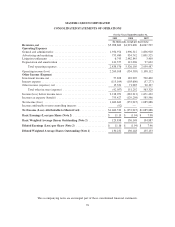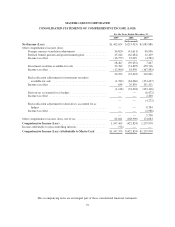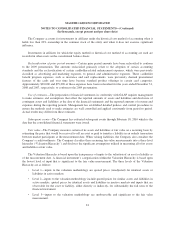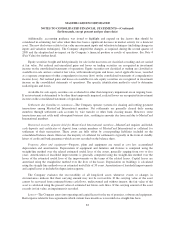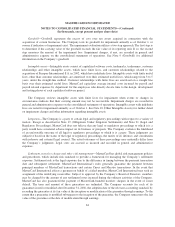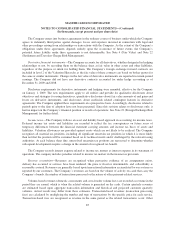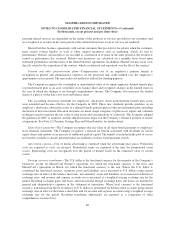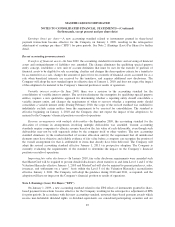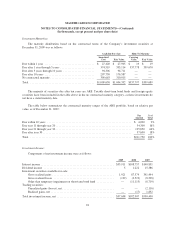MasterCard 2009 Annual Report Download - page 95
Download and view the complete annual report
Please find page 95 of the 2009 MasterCard annual report below. You can navigate through the pages in the report by either clicking on the pages listed below, or by using the keyword search tool below to find specific information within the annual report.MASTERCARD INCORPORATED
NOTES TO CONSOLIDATED FINANCIAL STATEMENTS—(Continued)
(In thousands, except percent and per share data)
The Company enters into business agreements in the ordinary course of business under which the Company
agrees to indemnify third parties against damages, losses and expenses incurred in connection with legal and
other proceedings arising from relationships or transactions with the Company. As the extent of the Company’s
obligations under these agreements depends entirely upon the occurrence of future events, the Company’s
potential future liability under these agreements is not determinable. See Note 4 (Fair Value) and Note 22
(Settlement and Travelers Cheque Risk Management).
Derivative financial instruments—The Company accounts for all derivatives, whether designated in hedging
relationships or not, by recording them on the balance sheet at fair value in other assets and other liabilities,
regardless of the purpose or intent for holding them. The Company’s foreign exchange forward contracts are
included in level 2 of the Valuation Hierarchy as the fair value of these contracts are based on broker quotes for
the same or similar instruments. Changes in the fair value of derivative instruments are reported in current-period
earnings. The Company did not have any derivative contracts accounted for under hedge accounting as of
December 31, 2009 and 2008.
Disclosure requirements for derivative instruments and hedging were amended, effective for the Company
on January 1, 2009. The new requirements apply to all entities and provide for qualitative disclosures about
objectives and strategies for using derivatives, quantitative disclosures about fair value amounts of and gains and
losses on derivative instruments, and disclosures about credit-risk related contingent features in derivative
agreements. The Company applied these requirements on a prospective basis. Accordingly, disclosures related to
periods prior to the date of adoption have not been presented. Since this revision relates to disclosures only, it
had no impact on the Company’s financial position or results of operations. See Note 23 (Foreign Exchange Risk
Management) for further detail.
Income taxes—The Company follows an asset and liability based approach in accounting for income taxes.
Deferred income tax assets and liabilities are recorded to reflect the tax consequences on future years of
temporary differences between the financial statement carrying amounts and income tax bases of assets and
liabilities. Valuation allowances are provided against assets which are not likely to be realized. The Company
recognizes all material tax positions, including all significant uncertain tax positions in which it is more likely
than not that the position will be sustained based on its technical merits and if challenged by the relevant taxing
authorities. At each balance sheet date, unresolved uncertain tax positions are reassessed to determine whether
subsequent developments require a change in the amount of recognized tax benefit.
The Company records interest expense related to income tax matters as interest expense in its statement of
operations. The company includes penalties related to income tax matters in the income tax provision.
Revenue recognition—Revenues are recognized when persuasive evidence of an arrangement exists,
delivery has occurred or services have been rendered, the price is fixed or determinable, and collectibility is
reasonably assured. Revenues are generally based upon transactional information accumulated by our systems or
reported by our customers. The Company’s revenues are based on the volume of activity on cards that carry the
Company’s brands, the number of transactions processed or the nature of other payment-related services.
Volume-based revenues (domestic assessments and cross-border volume fees) are recorded as revenue in the
period they are earned, which is when the related volume is generated on the cards. Certain quarterly revenues
are estimated based upon aggregate transaction information and historical and projected customer quarterly
volumes. Actual results may differ from these estimates. Transaction-based revenues (transaction processing
fees) are calculated by multiplying the number and type of transactions by the specific price for each service.
Transaction-based fees are recognized as revenue in the same period as the related transactions occur. Other
85



